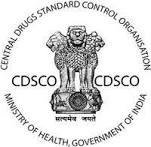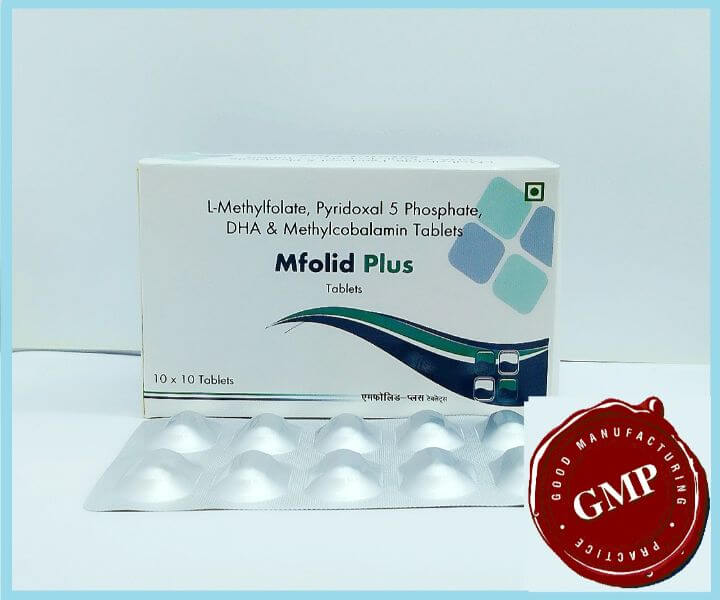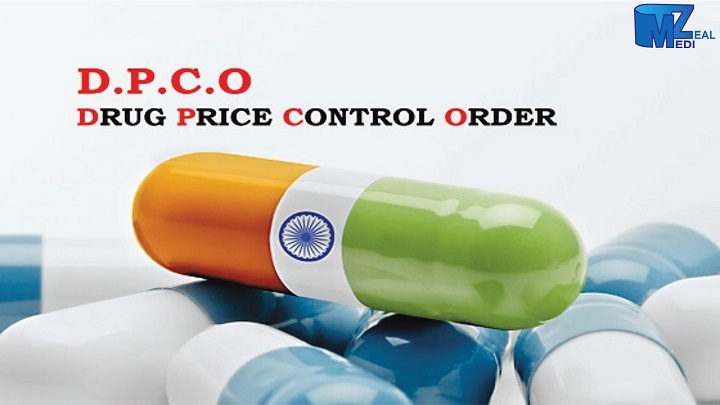MFOLID PLUS Tablets
MFOLID PLUS Tablet is used for Low folate levels, Exhaustion, Fretfulness, Depression, Nervousness, Irritability, Dizziness, Fatigue, Cracks around mouth and eyes, Dermatitis, Acne and to treat nerve damage mainly in the hands and feet, reduce inflammation and your risk of chronic diseases, such as heart disease. On its own, DHA supports brain function and eye health.
Another great product from house of MediZeal Pharma's PCD pharma franchise business
COMPOSITION
L-Methylfolate 1mg+Pyridoxal 5 Phosphate 0.5mg+Methylcobalamin 1500 mcg+DHA 200 mg
DESCRIPTION
MFOLID PLUS Tablet contain L-Methylfolate + Pyridoxal 5 Phosphate + Methylcobalamin + DHA. L-Methylfolate plays a critical role in methylating homocysteines into methionine by acting as a methyl donor in a reaction catalyzed by vitamine B12-dependent methionine synthase. Homocysteine must either be further metabolized via transulfuration to become cysteine, taurine, and glutathione via a B6-dependent process, or re-methylated to become methionine again. Methionine formed from remethylation of homocysteine by levomefolic acid forms the downstream metabolite S-adenosylmethionine (SAMe), which is involved in numerous biochemical methyl donation reactions, including reactions forming monoamine neurotransmitters. Methylcobalamin belongs to a class of medicines called Water-Soluble Vitamins. Water-soluble vitamins include vitamin C and all of the vitamin B complex that performs vital functions in a variety of body system and is crucial for maintaining optimal health. Pyridoxal 5 Phosphate is a coenzyme of many enzymatic reactions. It is the active form of vitamin B6 which comprises three natural organic compounds, pyridoxal, pyridoxamine and pyridoxine. Pyridoxal phosphate acts as a coenzyme in all transamination reactions, and in some decarboxylation and deamination reactions of amino acids. The aldehyde group of pyridoxal phosphate forms a Schiff-base linkage with the epsilon-amino group of a specific lysine group of the aminotransferase enzyme. The alpha-amino group of the amino acid substrate displaces the epsilon-amino group of the active-site lysine residue. The resulting aldimine becomes deprotonated to become a quinoid intermediate, which in turn accepts a proton at a different position to become a ketimine. Ketimine becomes hydrolyzed so that the amino group remains on the protein complex. DHA and its conversion to other lipid signalling moleccules compete with the arachidonic acid cascade from endogenous phospholipids and shift the inflammatory state to being more anti-inflammatory. DHA inhibits endotoxin-stimulated production of IL-6 and IL-8 in human endothelial cells. Derivatives of DHA are anti-inflammatory lipid mediators. Lipid mediators resolvin D1 and protectin D1 all inhibit transendothelial migration of neutrophils, so preventing neutrophilic infiltration at sites of inflammation, resolvin D1 inhibits IL-1β production, and protectin D1 inhibits TNF and IL-1β production. Monoxydroxy derivative of DHA converted by LOX inhibit thromboxane-induced platelet aggregation. DHA supplementation has also shown to reduce the levels of serum C-reactive protein (CRP) and other circulating markers of inflammation such as neutrophils in hypertriglyceridemic men. DHA acts as a ligand at peroxisome proliferator-activated receptor (PPAR) gamma and alpha that regulate lipid signalling molecule-mediated transduction pathways and modulate inflammation. As a natural ligand, DHA induces a protective effect in retinal tissues by activating retinoid x receptors and subsequent ERK/MAPK signaling pathway in photoreceptors to promote their survival and differentiation, stimulating the expression of antiapoptotic proteins such as Bcl-2 and preserving mitochondrial membrane potential.
HOW TO USE:
Take as directed by your doctor or follow the direction printed on the product insert. Dosage is based on your condition. Tell your doctor if your condition persists or worsens.
INDICATION
- Low folate levels
- treat nerve damage
- Exhaustion
- Fretfulness
- Depression
- Nervousness
- Irritability
- Dizziness
- Fatigue
- Cracks around mouth and eyes
- Dermatitis
- Acne
- Inflamed eyes
- Age-related macular degeneration (AMD).
- Clogged arteries (coronary artery disease).
- High cholesterol.
- Supplement treatment for alzheimer's disease
- Improvement of memory
- Supplement treatment for cardiovascular diseases
- Supplement for fetal growth
Side Effects
- Rash
- Hives
- Itching
- Difficulty breathing
- Tightness in the chest
- Swelling of the mouth, face, lips, or tongue
- burning sensation (hot sensation)
- headache
- nausea
- pain at the site of injection in the muscles
- sweating (diaphoresis)
- Nausea
- Vomiting
- Stomach pain
- Loss of appetite
- Headache
- Tingling
- Sleepiness
- Low blood pressure
PRECAUTIONS:
Before using MFOLID PLUS Tablet, inform your doctor about your current list of medications, over the counter products (e.g. vitamins, herbal supplements, etc.), allergies, pre-existing diseases, and current health conditions (e.g. pregnancy, upcoming surgery, etc.). Some health conditions may make you more susceptible to the side-effects of the drug. Take as directed by your doctor or follow the direction printed on the product insert. Dosage is based on your condition. Tell your doctor if your condition persists or worsens. Important counseling points are listed below.
Anemia
Breastfeeding
Planning to become pregnant
Pregnancy
Aspirin-sensitivity
Diabetes
Low blood pressure
DRUG INTERACTIONS:
When two or more medicines are taken together, it can change how the medicines work and increase the risk of side-effects. In medical terms, this is called as a Drug Interaction.
If you use other drugs or over the counter products at the same time, the effects of MFOLID PLUS Tablet may change. This may increase your risk for side-effects or cause your drug not to work properly. Tell your doctor about all the drugs, vitamins, and herbal supplements you are using, so that you doctor can help you prevent or manage drug interactions. MFOLID PLUS Tablet may interact with the following drugs and products:
Carbamazepine
Cholestyramine
Colchicine
Colestipol
Fluorouracil
Ibuprofen
Phenobarbital
Phenytoin
Primidone
Valproic acid
Anti-Gout Drugs
Histamine H2-Antagonists
Antituberculosis Drugs
Antibiotics
Proton Pump Inhibitors
Amiodarone
Levodopa
Phenobarbital
Phenytoin
Aminosalicylic acid
Antibiotics
Chloramphenicol
Colchicine
H2 blockers
Proton pump inhibitors
OVERDOSE:
Do not use more than prescribed dose. Taking more medication will not improve your symptoms; rather they may cause poisoning or serious side-effects. If you suspect that you or anyone else who may have overdosed of MFOLID PLUS Tablet, please go to the emergency department of the closest hospital or nursing home. Bring a medicine box, container, or label with you to help doctors with necessary information.
STORAGE:
Store medicines at room temperature, away from heat and direct light. Do not freeze medicines unless required by package insert. Keep medicines away from children and pets.
MISSED DOSE:
If you miss a dose, take it as soon as you remember. If it is near the time of the next dose, skip the missed dose and resume your usual dosing schedule. Do not double the dose to catch up.
NOTES:
Do not share this medication with others.This medication has been prescribed for your current condition only. Do not use it later for another infection. A different medication may be necessary in those cases.With prolonged treatment, laboratory and/or medical tests (e.g., kidney and liver function, complete blood counts) should be performed periodically to monitor your progress or check for side effects. Consult your doctor for more details.

Report Problems to the Central Drugs Standard Control Organization
You are encouraged to report negative side effects of prescription drugs to the CDSCO. Visit the CDSCO website.








